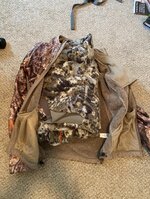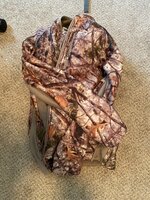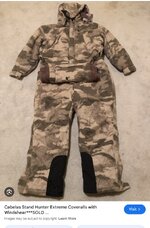OP, I’m in agreement with your observations. I think there are a number of reasons that I could fill this whole thread with, but in summary these “mobile hunting” companies are too small to diversify away from stands/saddles, and many are ignorant of clothing. Likewise, the western companies are likely ignorant of the really niche “mobile hunting” eastern crowd. Instead if they diversify like Sitka or firstlite, they appeal to the bulk of whitetail hunters hunting with side by sides and 4 wheelers who don’t care about weight/bulk. Selling “mobile hunting” eastern whitetail clothing is likely less profitable in comparison… however I do find this all ironic, because I don’t particularly think western hunting clothing specifically is that great either. Hiking, climbing, skiing, and etc brands do just about everything they do better and cheaper.
Having pondered your question before I know what I would like to see that doesn’t quite exist in a full form. There are items that are close, and I’ve mixed and matched solutions but I think it really comes down to 3 key pieces of clothing that need to be pretty different than what is routinely offered elsewhere:
1) an insulated outer static layer- you won’t move in this layer, so it doesn’t need to be overly durable aside from abrasion with tree bark. No Berber fleece, no membranes (this is where we’ll save our weight). The face fabric needs to be tightly woven for wind resistance and containing insulation, and it needs to be quiet. These textiles exist, but they’re not as marketable as “wind proof” membranes, and fuzzy looking exteriors, and they’re not as optimal for all other conditions one would want a puffy jacket for outside of white tails in the woods.
You could use down as the insulation, but I think a continuous filament synthetic would be better in humid environments with wet snow. It’ll withstand compression better than short staple insulation, and if it retains moisture, gets stuffed, and that moisture freezes, there will be fewer cold spots than you would get with down. I pretty much exclusively use down in my static insulation, but I concede this specific synthetic would be a better fit for the application.
The liner should be a soft handed nylon or polyester to glide over midlayers. The people who think it’s a good idea to use microfleece as liners on whitetail clothing should be hogtied and thrown in a closet during design committees. Most people use fleece midlayers and fleece on fleece binds horribly.
2) static bottoms - same criteria as above, but for static pants. Not bibs… pants. Bibs aren’t necessary for warmth and add extra weight. Noise is less of a concern for pants, so compromises on face fabric can be made to save weight/bulk. Don’t design them for walking, just putting on and sitting at location. Must make them a full or partial zip pant thats easy to get on and off with bulky footwear. Put extra insulation in the ass and knees that resist compression. Go heavy on the pants with the insulation. If you get hot, take them off or open the side zips to vent. Done.
3) create a supplemental midlayer perfectly tailored to layer inside the outer jacket - Make this a liner jacket much like the surplus m65 field jacket liner or the wiggys liner jacket. No collar, no pockets, tight cuffs at the arms, ugly as hell so there’s no confusion as to what this is intended for. Slick face and liner fabrics to glide within the system without resistance. Use a synthetic insulation that will resist sweat, and retain loft with layers on top of it. Wiggys lamlite, another continuous filament synthetic, does just that. Combine these with the outer stop layer to push the same jacket into colder temps.
4) secret item 4 if the above doesn’t suffice is a next to skin heated vest with a mesh backing to capture pockets of hot air. Heated clothing feels like cheating but it really is the best solution for stand hunting if you want minimal bulk and you can recharge batteries each night.
The above minimalist combination is exactly what I’d like to see and would cover 95% of any stand/saddle cold weather hunts, be it 3 miles or 30 yards from your vehicle. Outside of heated clothing, any mid or base layers can be had by any other brand and will perform just as well at managing moisture for hiking to and from your ambush point.
As for backpacks… I don’t know. I’ve arrived at a different solution so I haven’t explored it much. I use a Fjallraven Steuben for ground hunting that I can use as a stool, and a combination of a LWCG .5 and a Patagonia laundry bag for a stand. For carrying out a deer, i think either using a pack frame, or a really large stand that could double as your frame (like the lwcg 2.0) would be most efficient. I do this with the .5 but it’s for clothing, not deer limbs so the smaller size works. Combine this with a laundry style backpack. Essentially a ruck sack. It folds up to nothing and can be latched to the frame/stand. I use it for times that I leave my stand up in a tree the night before but need to bring clothes back out with me. You could also protect your clothes on a walk in too if need be. Pretty handy.
All this is to say, I think there are concepts floating around people make to work, but as you posited, no one has established a turn key mainstream static insulation layer that is both quiet and packable without a heavy weight/bulk penalty. There is room for optimization, I’m just not sure there’s enough money at the end of that rainbow to encourage the investment on a broad scale… there probably are enough people willing to buy, whether they need niche system like this or not, but convincing financiers would be the challenge Especially if you’re going for minimalism and versatility for this niche application because that means less products to sell.
I hope that bloated summary aligns with the spirit of what you were going for with this thread.



